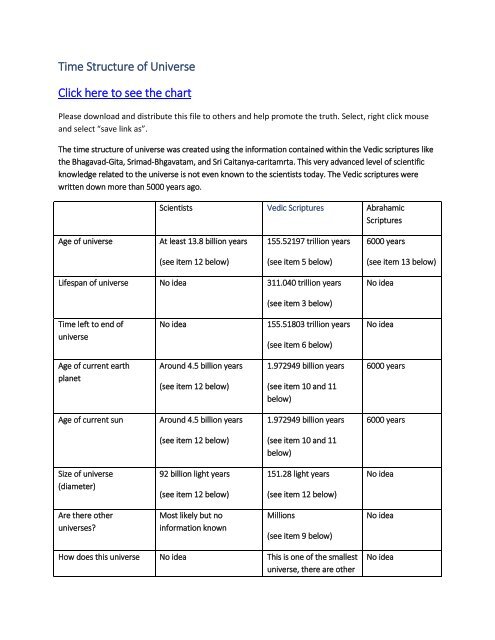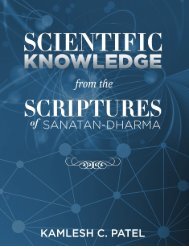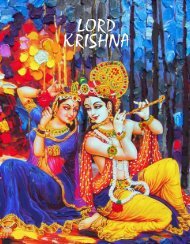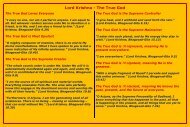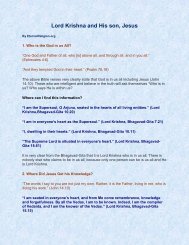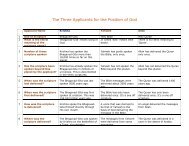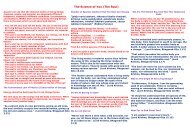time-structure-of-universe
How old is the universe?
How old is the universe?
You also want an ePaper? Increase the reach of your titles
YUMPU automatically turns print PDFs into web optimized ePapers that Google loves.
Time Structure <strong>of</strong> Universe<br />
Click here to see the chart<br />
Please download and distribute this file to others and help promote the truth. Select, right click mouse<br />
and select “save link as”.<br />
The <strong>time</strong> <strong>structure</strong> <strong>of</strong> <strong>universe</strong> was created using the information contained within the Vedic scriptures like<br />
the Bhagavad-Gita, Srimad-Bhgavatam, and Sri Caitanya-caritamrta. This very advanced level <strong>of</strong> scientific<br />
knowledge related to the <strong>universe</strong> is not even known to the scientists today. The Vedic scriptures were<br />
written down more than 5000 years ago.<br />
Scientists Vedic Scriptures Abrahamic<br />
Scriptures<br />
Age <strong>of</strong> <strong>universe</strong><br />
At least 13.8 billion years<br />
155.52197 trillion years<br />
6000 years<br />
(see item 12 below)<br />
(see item 5 below)<br />
(see item 13 below)<br />
Lifespan <strong>of</strong> <strong>universe</strong> No idea 311.040 trillion years<br />
No idea<br />
(see item 3 below)<br />
Time left to end <strong>of</strong><br />
<strong>universe</strong><br />
No idea<br />
155.51803 trillion years<br />
(see item 6 below)<br />
No idea<br />
Age <strong>of</strong> current earth<br />
planet<br />
Around 4.5 billion years<br />
(see item 12 below)<br />
1.972949 billion years<br />
(see item 10 and 11<br />
below)<br />
6000 years<br />
Age <strong>of</strong> current sun<br />
Around 4.5 billion years<br />
1.972949 billion years<br />
6000 years<br />
(see item 12 below)<br />
(see item 10 and 11<br />
below)<br />
Size <strong>of</strong> <strong>universe</strong><br />
(diameter)<br />
92 billion light years<br />
(see item 12 below)<br />
151.28 light years<br />
(see item 12 below)<br />
No idea<br />
Are there other<br />
<strong>universe</strong>s?<br />
Most likely but no<br />
information known<br />
Millions<br />
(see item 9 below)<br />
No idea<br />
How does this <strong>universe</strong> No idea This is one <strong>of</strong> the smallest<br />
<strong>universe</strong>, there are other<br />
No idea
compare with others?<br />
<strong>universe</strong>s which are<br />
thousands <strong>of</strong> <strong>time</strong>s<br />
bigger than this <strong>universe</strong><br />
All the above will be discussed in detail below.<br />
1. Day <strong>of</strong> Brahma (Kalpa)<br />
“By human calculation, a thousand ages taken together form the duration <strong>of</strong> Brahma's one day. And such<br />
also is the duration <strong>of</strong> his night.” (Lord Krishna, Bhagavad-Gita 8.17)<br />
The four yugas or ages are as follows:<br />
Satya yuga<br />
Dvapara yuga<br />
Treta yuga<br />
Kali yuga<br />
Total <strong>of</strong> 4 yugas<br />
1,728,000 years<br />
1,296,000 years<br />
864,000 years<br />
432,000 years<br />
4,320,000 years (4.32 million)<br />
A thousand <strong>of</strong> 4 yugas is 4.32 x 1000 = 4.32 billion years<br />
Thus one day<strong>time</strong> (12 hours) <strong>of</strong> Brahma is 4.32 billion years<br />
(The above is from the purport <strong>of</strong> 8.17)<br />
2. Divya-yuga/Chaturyuga<br />
The four yugas are also confirmed in Caitanya-caritamrta:<br />
“We know that there are four ages [yugas], namely Satya, Treta, Dvapara and Kali. These four together<br />
constitute one divya-yuga.” (Sri Caitanya-caritamrta Adi-Lia 3.7)<br />
The four yugas together is called a divya-yuga, which is also called a Chaturyuga, chatur means 4.<br />
3. Lifespan <strong>of</strong> <strong>universe</strong><br />
“O son <strong>of</strong> Kunte, at the end <strong>of</strong> the millennium all material manifestations enter into My nature, and at the<br />
beginning <strong>of</strong> another millennium, by My potency, I create them again.” (Lord Krishna, Bhagavad-Gita 9.7)<br />
From the purport <strong>of</strong> this verse it defines “At the end <strong>of</strong> the millennium” means at the death <strong>of</strong> Brahma.<br />
Brahma lives for 100 <strong>of</strong> his years which is calculated as follows:
4.32 (12 hours) x 2 (24 hours) x 30 (days in month) x 12 (months in year) x 100 (100 years)=311.040 trillion<br />
(311 trillion, 40 billion years)<br />
(The above is from the purport <strong>of</strong> 8.17)<br />
4. Manvantaras<br />
Each day <strong>of</strong> Brahma is divided into fourteen parts called manvantaras. Each manvantara has a different<br />
Manu and the current Manu is the seventh, called Vaivasvata. Each manvantara is divided into 71 parts<br />
called divya-yugas (also called chaturyugas).<br />
We are now in the twenty-eight divya-yuga <strong>of</strong> the seventh manvantara. Before the first and after each<br />
manvantara, there is a juncture (sandhya) period <strong>of</strong> duration 1,728,000 years.<br />
“Seventy-one divya-yugas constitute one manv-antara. There are fourteen manv-antaras in one day <strong>of</strong><br />
Brahma. The present Manu, who is the seventh, is called Vaivasvata [the son <strong>of</strong> Vivasvan]. Twenty-seven<br />
divya-yugas [27 x 4,320,000 solar years] <strong>of</strong> his age have now passed.” (Sri Caitanya-caritamrta Adi-Lila 3.8-9)<br />
The names <strong>of</strong> the fourteen Manus are as follows: (1) Svayambhuva, (2) Svarocisa, (3) Uttama, (4) Tamasa,<br />
(5) Raivata, (6) Caksusa, (7) Vaivasvata, (8) Savarni, (9) Daksa-savarni, (10) Brahma-savarni, (11) Dharmasavarni,<br />
(12) Rudraputra (Rudra-savarni), (13) Raucya, or Deva-savarni, (14) and Bhautyaka, or Indra-savarni.<br />
(From the purport <strong>of</strong> 3.9)<br />
5. Current Age <strong>of</strong> Universe<br />
Brahma is in his 1st day <strong>of</strong> his 51st year. In his current day, he has passed 1972.949 million Earth years,<br />
which is 5 hours, 28 mins, and 49 seconds for Brahma. When 100,000 years pass on planet Earth, only 1<br />
second passes for Brahma.<br />
The current age <strong>of</strong> Brahma and the <strong>universe</strong> is 155.52197 trillion years.<br />
“The one hundred years <strong>of</strong> Brahma's life are divided into two parts, the first half and the second half. The<br />
first half <strong>of</strong> the duration <strong>of</strong> Brahma's life is already over, and the second half is now current.” (Srimad-<br />
Bhagavtam 3.11.34)<br />
6. Time to End <strong>of</strong> Universe<br />
311.040 (lifespan <strong>of</strong> <strong>universe</strong>/Brahma) - 155.52197 (current age <strong>of</strong> <strong>universe</strong>/Brahma)=155.51803 trillion<br />
years<br />
7. Duration <strong>of</strong> One Breath <strong>of</strong> Maha-Visnu<br />
The entire duration <strong>of</strong> the life <strong>of</strong> Brahma and the <strong>universe</strong> <strong>of</strong> 311.040 trillion years is less than a second for<br />
Maha-Visnu. This is the <strong>time</strong> that passes when Maha-Visnu exhales or inhales just once. Maha-Visnu is just<br />
an expansion <strong>of</strong> Lord Krishna. This is how great Lord Krishna (God) is.
“The duration <strong>of</strong> the two parts <strong>of</strong> Brahma's life, as above mentioned, is calculated to be equal to one<br />
nimesa [less than a second] for the Supreme Personality <strong>of</strong> Godhead, who is unchanging and unlimited and<br />
is the cause <strong>of</strong> all causes <strong>of</strong> the <strong>universe</strong>.” (Srimad-Bhagavtam 3.11.38)<br />
8. Manifestation <strong>of</strong> Life<br />
“At the beginning <strong>of</strong> Brahma's day, all living entities become manifest from the unmanifest state, and<br />
thereafter, when the night falls, they are merged into the unmanifest again.” (Lord Krishna, Bhagavad-Gita<br />
8.18)<br />
Life is manifest in this <strong>universe</strong> only during the day<strong>time</strong> <strong>of</strong> Brahma. With the onset <strong>of</strong> Brahma’s night, all<br />
living beings are annihilated and the entire <strong>universe</strong> is plunged into darkness. When another day <strong>of</strong> Brahma<br />
begins, life again becomes manifest.<br />
9. Our <strong>universe</strong> is one <strong>of</strong> the smallest<br />
“Krsna said: Your particular <strong>universe</strong> has a diameter <strong>of</strong> four billion miles.. Some <strong>of</strong> the <strong>universe</strong>s are one<br />
billion yojanas [8 billion miles] in diameter, some one trillion [8 trillion miles], some ten trillion [80<br />
trillion miles] and some one hundred trillion yojanas [800 trillion miles]. Thus they are almost<br />
unlimited in area.” (Lord Krishna to Brahma, Caitanya-caritamrta Madhya-Lila 21.84)<br />
“This universal egg, or the <strong>universe</strong> in the shape <strong>of</strong> an egg, is called the manifestation <strong>of</strong> material energy.”<br />
(Srimad-Bhagavatam 3.26.52)<br />
The Vedic knowledge is that there are bubbles <strong>of</strong><br />
<strong>universe</strong>s in the material creation. This theory is now<br />
supported by the scientists and is known as<br />
Multiverse.<br />
“These <strong>universe</strong>s are understood to be floating in<br />
the air that Mahā-Viṣṇu exhales. They are like<br />
atomic particles that float in sunshine and pass<br />
through the holes <strong>of</strong> a screen. All these <strong>universe</strong>s<br />
are thus created by the exhalation <strong>of</strong> Mahā-Viṣṇu,<br />
and when Mahā-Viṣṇu inhales, they re-enter His<br />
body. The unlimited opulences <strong>of</strong> Mahā-Viṣṇu are<br />
completely beyond material conception.” (Sri<br />
Caitanya-caritamrta Madhya-Lila 20.279-280)<br />
Multiverse picture – Credit: Florida State University<br />
“After creating the total number <strong>of</strong> <strong>universe</strong>s,<br />
which are unlimited, Maha-Viṣṇu expanded<br />
Himself into unlimited forms and entered into<br />
each <strong>of</strong> them.” (Sri Caitanya-caritamrta Madhya-
Lila 20.284)<br />
“The whole cosmic order is under Me. Under My<br />
will it is automatically manifested again and again,<br />
and under My will it is annihilated at the end.”<br />
(Lord Krishna, Bhagavad-Gita 9.8)<br />
10. Calculation <strong>of</strong> <strong>time</strong> passed in the current day <strong>of</strong> Brahma<br />
Time passed in current day 1972.949 million years (based on our clock)<br />
1 day for Brahma = 4.32 billion = 4320 million<br />
1 hour for Brahma = 4320/12 = 360 million<br />
1 minute for Brahma = 360/60 = 6 million<br />
1 second for Brahma = 6/60 = 0.1 million = 100,000 years<br />
1972.949/360 = 5.4804138 hours<br />
5 hours<br />
0.4804138 hours = 0.4804138 x 60 minutes = 28.824828 minutes<br />
28 minutes<br />
0.824828 minutes = 0.824828 x 60 seconds = 49.489 seconds<br />
Time passed in current day <strong>of</strong> Brahma is 5 hours, 28 minutes, and 49 seconds (based on Brahma’s clock)<br />
11. Age <strong>of</strong> current Earth and Sun<br />
At the beginning <strong>of</strong> each day <strong>of</strong> Brahma, he creates the sun, earth and other planets. At the end <strong>of</strong> each day<br />
<strong>of</strong> Brahma, the sun, earth, and some other planets are completely destroyed. Then again the next day, he<br />
creates and so on. Thus the age <strong>of</strong> the current earth and sun is the age <strong>of</strong> Brahma in his current day, which<br />
is 1.972949 billion years (see #10).<br />
12. Diameter <strong>of</strong> <strong>universe</strong><br />
Ariel View <strong>of</strong> Our Universe
“Sukadeva Goswame said: My dear King, I have thus far described the diameter <strong>of</strong> the <strong>universe</strong> [fifty crores<br />
<strong>of</strong> yojanas, or four billion miles] and its general characteristics, according to the estimations <strong>of</strong> learned<br />
scholars.” (Srimad-Bhagavatam 5.21.1)<br />
“The layers or elements covering the <strong>universe</strong>s are each ten <strong>time</strong>s thicker than the one before, and all the<br />
<strong>universe</strong>s clustered together appear like atoms in a huge combination.” (Srimad-Bhagavatam 3.11.41)<br />
“I have described the nine basic elements as the enjoying soul, nature, nature’s primeval manifestation <strong>of</strong><br />
the mahat-tattva, false ego, ether, air, fire, water and earth.” (Srimad-Bhagavatam 11.22.14)<br />
1. The inner core <strong>of</strong> the <strong>universe</strong> is called the Bhu-Mandala. This is 2 billion miles in radius from the<br />
center <strong>of</strong> the <strong>universe</strong>.<br />
2. The Bhu-Mandala is covered with layers. The first layer is particles <strong>of</strong> earth. This is 40 billion<br />
miles from the end <strong>of</strong> the core to the next layer.<br />
3. The second layer is water particles or water vapors. This is 400 billion miles from the end <strong>of</strong> the<br />
first layer to the end <strong>of</strong> the second layer.<br />
4. The third layer is heat or fire and this is 4000 billion miles from the end <strong>of</strong> the second layer to<br />
the end <strong>of</strong> the third layer.<br />
5. The fourth layer is air and this is 40,000 billion miles.<br />
6. The fifth layer is ether or sky and this is 400,000 billion miles.<br />
Total distance from the center <strong>of</strong> the <strong>universe</strong> to the end <strong>of</strong> the <strong>universe</strong>:<br />
= 2 billion + 40 billion + 400 billion + 4000 billion + 40,000 billion + 400,000 billion<br />
= 444442 x 10^9 miles<br />
1 Light year is 5876025120000 miles<br />
The <strong>time</strong> it would take light to travel from the center <strong>of</strong> the <strong>universe</strong> to the end <strong>of</strong> the <strong>universe</strong>:<br />
= 444442X10^9/5876025120000
= 75.64 light years<br />
Diameter <strong>of</strong> the <strong>universe</strong> is 444442x10^9x2= 888884 x 10^9 miles<br />
The <strong>time</strong> it would take light to travel from one end <strong>of</strong> the <strong>universe</strong> to the other = 75.64X2= 151.28 light<br />
years<br />
The above is just a general calculation based on one understanding and interpretation <strong>of</strong> the<br />
Vedic scriptural information on the <strong>universe</strong>. There are other interpretations, which may give<br />
different results.<br />
The diameter <strong>of</strong> the <strong>universe</strong> based on the Vedic scriptures is 151.28 light years, and based on the scientists<br />
is 93 billion light years. A very big difference, and this difference is explained from different angles below.<br />
a. The estimate by the scientist is always changing, and they themselves admit that it could be wrong.<br />
The Vedic numbers have been written down and fixed for more than 5000 years, they never<br />
change, because the Vedic knowledge comes from the Supreme scientists, Lord Krishna (God).<br />
b. The scientists determine the distance by calculating how long light has traveled from a distant<br />
galaxy in space to reach us. Since there is no known fixed point from which to measure the light,<br />
they could be measuring the light from another <strong>universe</strong> or some other point. The scientists don’t<br />
know.<br />
c. The <strong>universe</strong> is always expanding and thus the light from distant galaxies is always moving away<br />
from us and thus the diameter (distance from the origin) <strong>of</strong> the <strong>universe</strong> is always increasing.<br />
d. The definition <strong>of</strong> <strong>universe</strong> based on the scientists and the Vedic scriptures is different, and thus we<br />
cannot really expect the 2 values to be equal or close, since there is no agreement on the definition<br />
<strong>of</strong> <strong>universe</strong> between the two sources.<br />
e. The scientists are assuming that this is the only <strong>universe</strong> in the material creation, whereas the<br />
Vedic knowledge is that the material creation is comprised <strong>of</strong> millions <strong>of</strong> <strong>universe</strong>s. The scientists<br />
use the term ‘observable <strong>universe</strong>’ instead <strong>of</strong> ‘<strong>universe</strong>’, because they are not sure whether they<br />
are measuring in one <strong>universe</strong> or from another <strong>universe</strong> or from somewhere outside.<br />
f. The scientists have no solid evidence to prove that their ability to measure <strong>time</strong> and distance in<br />
billions <strong>of</strong> years is accurate.<br />
Speed <strong>of</strong> light =186,282 miles per second<br />
1 light year= 5.88 trillion miles (5.88 x 10^12)<br />
13. Age <strong>of</strong> Earth/Universe based on Bible<br />
By adding up the ages provided in Genesis 5 and 11, it becomes apparent that the Bible teaches the<br />
earth and <strong>universe</strong> to be about 6000 years old. This is also confirmed by many Christians and the
Muslims also accept that Adam and Eve were the first humans created by God. It is clearly stated in<br />
many sources that Adam and Eve lived about 6000 years ago.<br />
Summary Explanation <strong>of</strong> the Chart<br />
The top line represents the lifespan <strong>of</strong> the <strong>universe</strong>, which is directly related to the life <strong>of</strong> a person called<br />
Brahma. Brahma is the first living being created in the <strong>universe</strong> by Lord Vishnu. When Brahma dies, the<br />
<strong>universe</strong> also dies. The whole lifespan <strong>of</strong> Brahma and the <strong>universe</strong> is called a Maha Kalpa, which is <strong>of</strong><br />
duration 311 trillion, 40 billion years. This is also the <strong>time</strong> that passes for us when Maha-Visnu exhales or<br />
inhales just once. This means that when Maha-Visnu exhales just once, 311 trillion, 40 billion years pass for<br />
us. This is how great Lord Krishna (God) is.<br />
The arrow pointing up below the first horizontal line represents the current <strong>time</strong> position <strong>of</strong> Brahma and<br />
the <strong>universe</strong>. Brahma has passed 50 years and he is now 5 hours, 28 minutes, and 49 seconds into his 1 st<br />
day <strong>of</strong> his 51 st year. The current age <strong>of</strong> Brahma and the <strong>universe</strong> is 155 trillion, 521 billion, and 970 million<br />
years (155.52197 trillion). The <strong>time</strong> left before end <strong>of</strong> <strong>universe</strong> and end <strong>of</strong> the life <strong>of</strong> Brahma is 311.040<br />
trillion – 155.52197 trillion = 155.51803 trillion years (155 trillion, 518 billion, and 30 million years).<br />
Each day <strong>of</strong> Brahma is called a Kalpa, with duration <strong>of</strong> 4.32 billion years and is divided into 14 parts called<br />
Manvantaras. Each Manvantara is <strong>of</strong> duration 306 million, and 720 thousand years, and divided into 71<br />
parts called Chatuyugas. Each Chaturyuga is <strong>of</strong> duration 4 million, and 320 thousand years. In the current<br />
day <strong>of</strong> Brahma, we have passed 6 Manvantaras and are now in the 7 th Manvantara. Within the 7 th<br />
Manvantara, we have passed 27 Chaturyugas and are now in the 28 th Chaturyuga.<br />
Each Chaturyuga is divided into 4 parts called yugas. We are currently 5000 years into the Kali-yuga and we<br />
have another 427,000 years before the end <strong>of</strong> kali-yuga. Then we move into the 29 th Chaturyuga, and<br />
through the remaining Chaturyugas in the 7 th Manvantara and then into the 8 th Manvnatara and so on and<br />
after the 14 th Manvantara, we move into the next day <strong>of</strong> Brahma and the whole cycle is repeated.


